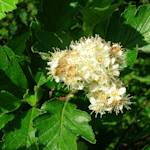American Chestnut, Castanea dentata
1940's • Eastern United States
"All words about the American Chestnut are now but an elegy for it. This once mighty tree, one of the grandest features of our sylva, has gone down like a slaughtered army before a foreign fungus disease, the Chestnut blight. In the youth of a man not yet old, native Chestnut was still to be seen in glorious array, from the upper slopes of Mount Mitchell, the great forest below waving with creamy white Chestnut blossoms in the crowns of the ancient trees, so that it looked like a sea with white combers plowing across its surface. Gone forever is that day; gone is one of our most valuable timber trees, gone the beauty of its shade, the spectacle of its enormous trunks sometimes ten to twelve feet in diameter. And gone the harvest of the nuts that stuffed our Thanksgiving turkey or warmed our hearts and fingers at the vendor’s street corner." - Donald Culross Peattie, A Natural History of Trees of Eastern and Central North America, 1950 The blight, that all but wiped out the American Chestnut, began in the late 19th century with the importation of chestnut trees from Asia, Castanea mollissima, which carried the disease. By the 1940s, over 3.5 billion trees were dead from the disease, decimating the complex ecology of the Appalachian Forest, where the American Chestnut was once a keystone species.
Peattie, Donald. A Natural History of Trees of Eastern and Central North America. Houghton Mifflin, 1950. Chestnut Blight and the Good Virus - Great Smoky Mountains National Park (U.S. National Park Service).” National Park Service, 12 Oct. 2017, www.nps.gov/grsm/learn/nature/dff10-chestnut.htm.
Botanical illustration of Castanea dentata from The North American sylva, compiled by Francois Andre Michaux and Augustus Lucas Hillhouse in 1819


Learn about Maya Lin’s fifth and final memorial: a multi-platform science based artwork that presents an ecological history of our world - past, present, and future.

Discover ecological histories and stories of former abundance, loss, and recovery on the map of memory.

Learn how we can reduce our emissions and protect and restore species and habitats – around the world.

See how art can help us rethink the problems we face, and give us hope that each one of us can make a difference.

Help make a global memorial something personal and close to home. Share your stories of the natural world.


